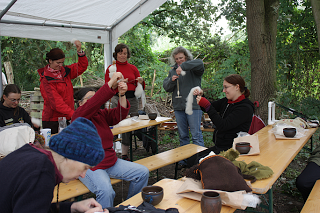I took the day off yesterday (well, mostly) and had a wonderfully relaxing time just reading, snacking, relaxing and napping, so now my wakefulness-levels are almost normal again.
Now that I'm in the quiet of my own little study again (crammed full with the boxes of the experiment), I really start to miss the chatter and bad jokes and friendly banter and "string talk" of last week. And slowly I realise that the Textilforum has indeed taken place, that we really did it, that the experiment was really wildly successful, and that I have a heap of things to remember the wonderful week by, including my first ever badge for making a fire without more than two matches (heehee! All that training was worth it!), the most ugly cardboard-piggybank ever made by man or woman (and a very well-fed one at that, thanks to the generous people at the Forum) and the now-famed cat timer that usually resides on my workdesk but had taken a venture out and did some important work in the spinning experiment.
There are already some pictures online at Phiala's blog, summing up nicely all the things that went on, including the silliness. Here's a random picture taken during the spinning experiment (they are not sorted yet, of course...):

Now that I'm in the quiet of my own little study again (crammed full with the boxes of the experiment), I really start to miss the chatter and bad jokes and friendly banter and "string talk" of last week. And slowly I realise that the Textilforum has indeed taken place, that we really did it, that the experiment was really wildly successful, and that I have a heap of things to remember the wonderful week by, including my first ever badge for making a fire without more than two matches (heehee! All that training was worth it!), the most ugly cardboard-piggybank ever made by man or woman (and a very well-fed one at that, thanks to the generous people at the Forum) and the now-famed cat timer that usually resides on my workdesk but had taken a venture out and did some important work in the spinning experiment.
There are already some pictures online at Phiala's blog, summing up nicely all the things that went on, including the silliness. Here's a random picture taken during the spinning experiment (they are not sorted yet, of course...):




